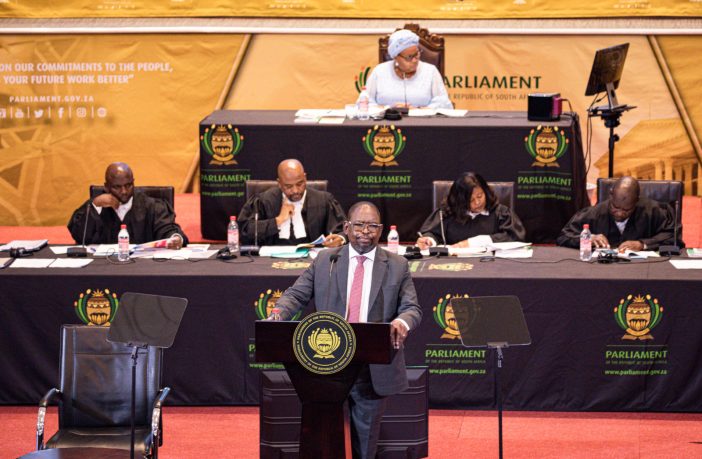- South Africa’s Minister of Finance, Mr Enoch Godongwana, delivered his 2024 Budget yesterday.
- Here are the energy sector takeaways.
Treasury will release the long awaited report on the independent review of Eskom’s coal-fired power stations in the coming week. The recommendations will feed into Eskom’s corporate plans to bolster accountability and oversight plus inform part of the conditions attached to the their debt relief plan. Eskom was awarded a financial package worth R254-billion in the 2022 Budget which will be disbursed in tranches over three years provided certain conditions are met. Godongwana announced that R44-billion has been transferred to the utility to date.
Godongwana said that it is through the combination of private investment in new energy projects, rooftop solar installations and improvements in Eskom’s generation fleet that load shedding will reduce, and reliability and security of supply improve. To support these efforts the government will introduces a new R2 billion conditional grant over the medium term to fund the rollout of smart prepaid meters. This will begin with municipalities that have been approved for debt relief.
Related news: Eskom is in a ‘utility death spiral’
Municipal debt
“By December 2023, 72 applications had been submitted, totalling R56.7 billion or 96.9 % of total municipal debt owed to Eskom at end‐March 2023. [Some] 70 applications totalling R55.2 billion had been approved as of January 2024, said Godongwana.
Once municipalities are admitted into the programme, strict conditions set by Treasury have to be followed in order for the debt to be written off over a three-year period.
“These conditions include enforcing strict credit controls, paying their monthly electricity accounts and enhancing revenue collection,” Godongwana said.
Increase in carbon offset threshold
Godongwana announced an increase from 15MW to 30MW in the limit for renewable energy projects that qualify for the carbon offsets regime. This will encourage SME’s, who are plagued by daily loadshedding of up to 10 hours, to increase their self-generation capacity and enjoy the carbon offset tax benefit.
Reforms to facilitate public-private partnerships (PPP) and streamline approval processes
Godongwana announced that the PPP regulatory framework was gazetted earlier this week with the aim to reduce the procedural complexity of undertaking PPPs. He added that the move is intended to create capacity to support and manage PPPs, formulate clear rules for managing unsolicited bids and strengthen the governance of fiscal risk.
He also said a flow-through tax vehicle for specific infrastructure projects, similar to trusts and other investment vehicles, was being considered.
This is good news for South Africa’s power transmission sector which finds itself way short in parts of the country in terms of capacity to deal with the grid feed in of renewable energy and its associated intermittency challenges.
The country’s transmission infrastructure is designed mainly around base-load coal-fired power generation. To accommodate new generation capacity, the bulk of which will come from renewables, the country will need to quickly ramp up transmission infrastructure (transmission lines, transformer capacity and energy storage) to accommodate variable loads and ensure grid stability.
The Managing director of Eskoms’ new Transmission Company, Mr Segomoco Scheppers, has reported that the country needed to add more than 1500 km of new transmission lines annually over the next ten years. This is to ensure transmission capacity to accommodate more than 50 GW of new generation power which will mainly come from intermittent renewable energy (wind and solar projects).
Currently, Eskom’s transmission division is adding 300 km of new power lines annually. Scheppers confirmed that in the last ten years, only 4 347 km of new powerlines were added.
Another challenge is transformer capacity. Scheppers confirmed that more than 122 600 MVA transformation capacity would have to be added, representing 77% of Eskom’s current installed base of just over 160 000 MVA. In the last ten years, only 19 060 MVA has been added to the grid infrastructure.
Naresh Singh, Transmission Project General Manager, explains that transmission procurement processes at Eskom “have become bureaucratic, lethargic, non-value creating and ineffective”.
To overcome this, Scheppers announced that an EPC model would be used in tandem with Eskom’s more traditional procurement models.
The model would involve either Eskom Transmission or an owner’s engineer completing the front-end engineering design and overseeing the procurement of a single EPC contractor, which would be expected to complete the detailed design, procure the necessary material, and construct and commission the solution, before handing it over as a fully functional and compliant asset to the transmission division.
More recently in a virtual briefing on the countrys’ energy crisis, South Africa’s Minister of Electricity, Dr Kgosientsho Ramokgopa, confirmed that the National Energy Crisis Committee (Necom) is considering a public–private partnership model for transmission infrastructure to accommodate new generation capacity which includes intermittent renewable energy. The capex on this is pitched at R210-billion which Eskom and the government does not have. He added that there was no intention of relinquishing state ownership of the grid.
EV production value chain incentive
It was hoped that Godongwana would announce a reduction in the import tax for electric vehicles (EV’s). Currently, the country levies a 25% import tax on EVs, compared to 18% for internal combustion engine vehicles. EV’s which have comparatively higher prices, are also subject to ad valorem (luxury) tax.
Instead, Godongwana wants to incentivise local EV value chain manufacturing. He announced that the government would introduce an investment allowance for new investments from 1 March 2026 which will allow producers to claim 150% of qualifying investment spending on electric and hydrogen-powered vehicles in the first year. This incentive adds to the support under the Automotive Production Development Programme. He added that the government has also allocated R964 million over the medium term to support EV transition.
Link to the full 2024 Budget Speech HERE
Author: Bryan Groenendaal















